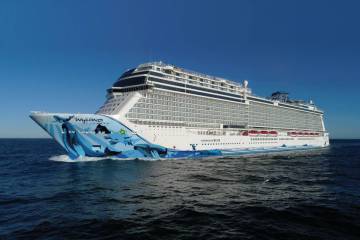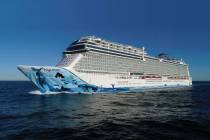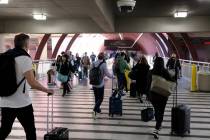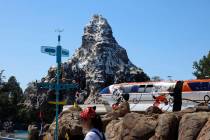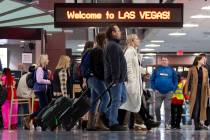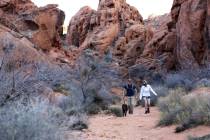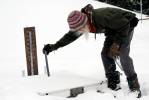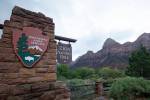Nevada’s ‘Tin Man’ treks Sierra on titanium knees
RENO — Shortly before a recently scheduled hike in the Sierra Nevada foothills, Peter Tremayne called to change plans.
Instead of a hiking from a Reno-area visitor center at around 6,200 feet in elevation, the new plan was to hike to Rose Knob Peak, elevation 9,773 feet, on a route that would include snow, scree and, eventually, a stop at a perch about 3,500 feet above Lake Tahoe.
It’s not surprising Tremayne, 75, would opt for something steeper and higher. All the better to prepare for his upcoming through-hike of the John Muir Trail, which will be his 12th in the past 13 years. The 2014 trip will also be Tremayne’s second since having both knees rebuilt with titanium, chrome alloy and plastic parts.
The surgeries, one in 2012 and the second last year, earned Tremayne the trail name “Tin Man” but haven’t kept him off the mountains.
“He got the new titanium knees and now he is out there kicking ass,” said Johannes Eichstaedt, 30, one of Tremayne’s hiking partners.
During the hike to Rose Knob Peak, Tremayne maintained a quick pace, pausing only to point out sights along a lightly used back route to the Tahoe Rim Trail, which eventually leads to the peak.
Using LEKI trekking poles, which he recommends people use whether they have replacement knees or not, he navigated deep snow, scree, steep grades and some off-trail travel.
“I was using them as crutches for a lot of those early trips I did,” he told the Reno Gazette-Journal. “They have very much become a part of me.”
In his earliest hikes after knee replacement, Tremayne also had some pain while rebuilding his range of motion while his legs still had scar tissue from the operation. He described stubbing his toe at one point and feeling a jolt in the back of his knee, it was enough painful enough to cause a stumble.
“Mainly I hurt my pride,” he said. He quickly added the instances of pain “are long gone.”
Dr. Eric Boydon said while knee replacements are gaining in popularity, Tremayne’s recovery and return to the trail is atypical.
“Most people aren’t going to achieve his level of function,” said Boydon, who performed the surgeries on Tremayne’s knees. “Even without knee replacement most people can’t do what he does.”
The surgery involves resurfacing the lower end of the femur with a cobalt chrome alloy and the upper end of the tibia with titanium and inserting a plastic spacer between them, Boydon said.
He said people who live healthy, active lifestyles and control their weight have a much greater chance of remaining active following knee replacement, even demanding activity such as hiking steep trails.
“These knees can certainly withstand that kind of activity,” Boydon said.
A few weeks after the Rose Knob hike, Tremayne said the right knee successfully passed a much greater stress test during a multi-day hike with Eichstaedt in the northern Yosemite backcountry.
The trip, about 60 miles mostly on the Pacific Crest Trail, went through deep snow on the northern faces. He described it as easy to kick steps into and walk but treacherous because it was falling through to rocks underneath.
At one point Tremayne’s right leg fell through and he lost his balance and fell backward with his head and shoulders downhill from his stuck leg.
“I was just basically hanging from that,” he said. “It bent beyond the normal amount it normally goes.”
Not only did the knee hold up to the fall, Tremayne and his hiking partner managed to swim across a stream swollen with snowmelt later on the same trip. The experience turned out to be “a great little adventure” he said.
“Little,” is about right, in the context of a lifetime of adventure for the former pilot and mountaineer.
Born in New Zealand, Tremayne was a member of the Royal New Zealand Air Force in 1959 when he was selected to participate in an Antarctic program, which was led by mountaineer Sir Edmund Hillary. The training took place in New Zealand’s southern alps with clothing and gear that would be considered long past primitive today.
“It was about glacial survival, falling down crevasses and getting out, that sort of thing,” he said.
It culminated in 1961 with four months of service in Antarctica through a joint program with the U.S. Navy.
Following his military career Tremayne worked as a commercial pilot firm that delivered new aircraft to owners around the world, for a mining company and with delivery service UPS.
In 1983, while continuing to work as a pilot, Tremayne returned to mountaineering and began making a long list of climbs, summits and attempts around the world. He and his wife, Lucy, who has accompanied him on many adventures, moved to Reno in 2008 from Washington. He also has three adult sons.
His website, www.HighSierraKiwi.com, details climbs in locations as varied as the Himalayas, the Cascades, Alaska and New Zealand, not all of them ending with a successful summit. In many instances, Tremayne said he’s turned back because an attempt would be too risky.
“I turned back from more summits than I ever got to, which is one of the reasons I’m still alive,” he said.
It’s an approach to risk management that still serves him as he’s shifted to through-hiking to get his mountain fix.
Tremayne said he has some, but not much, regret he never attempted to summit Mount Everest. When he was at the peak of his climbing career he said he couldn’t afford the cost and by the time he could it would have been, in his opinion, too risky to justify.
Still, he tromps through the Sierra Nevada each summer with much of the same love for high country that attracted him to mountaineering and the endurance of hikers decades younger.
“I’ve enjoyed all the peaks I’ve attempted,” Tremayne said. “Each one of them has been a little Everest for me.”
———
Information from: Reno Gazette-Journal, http://www.rgj.com






